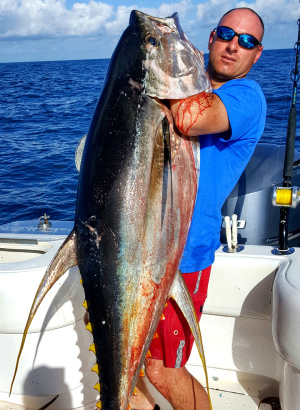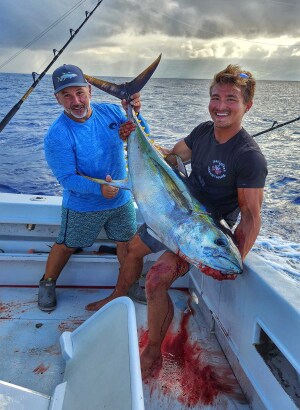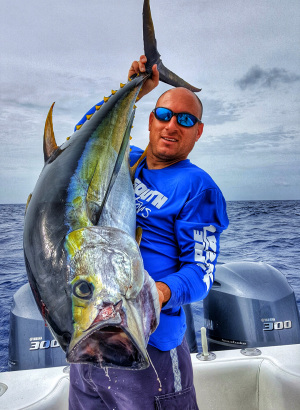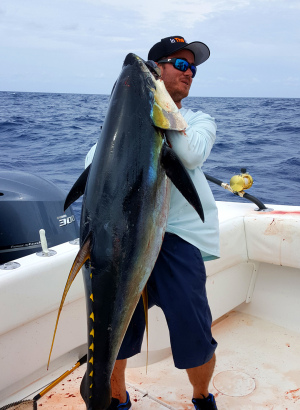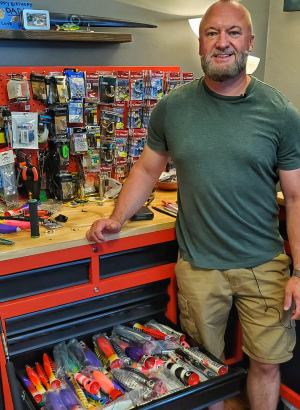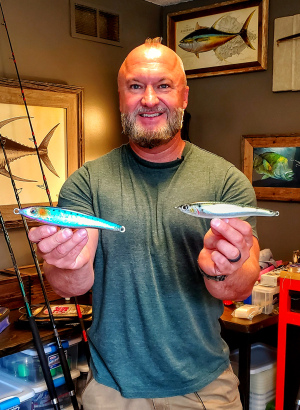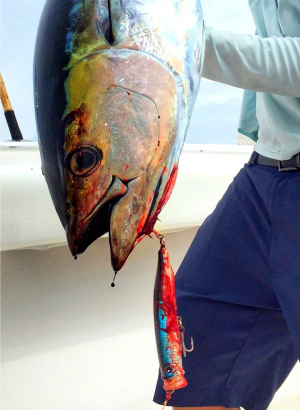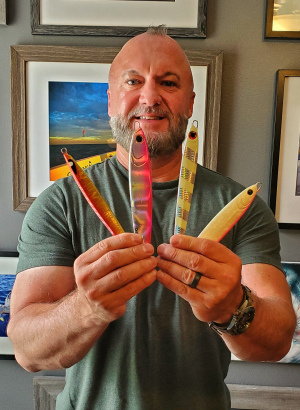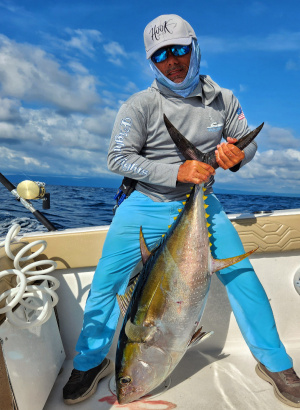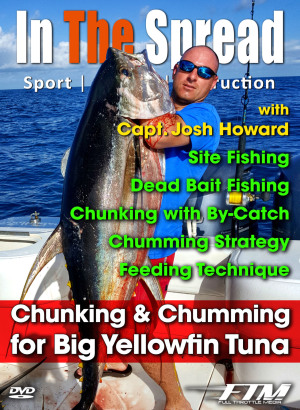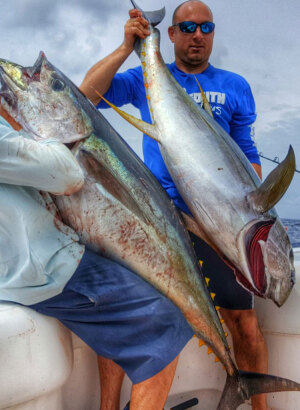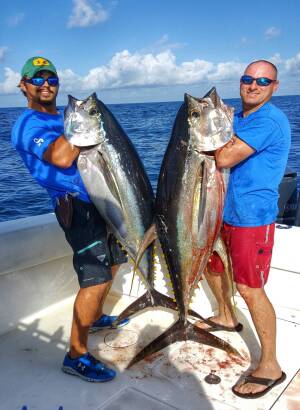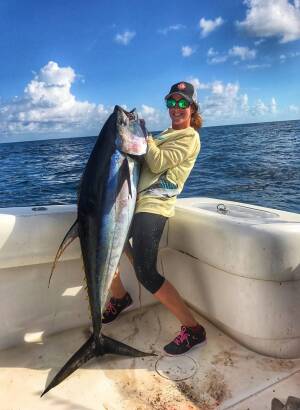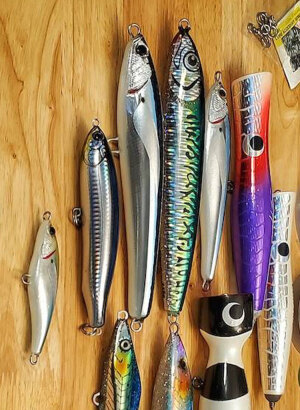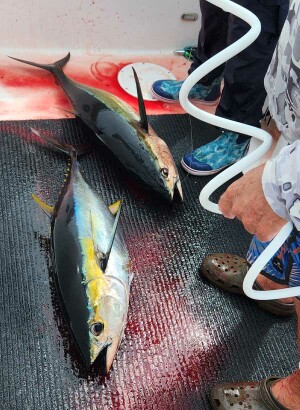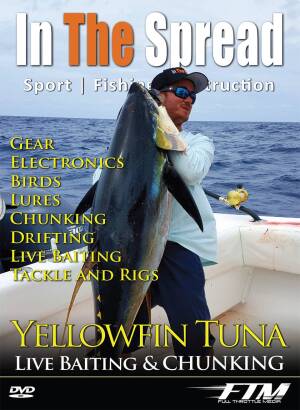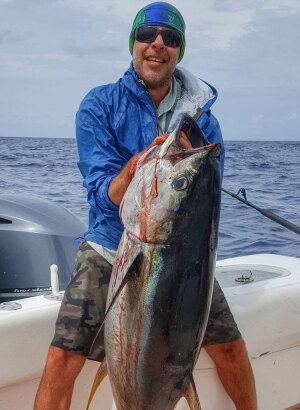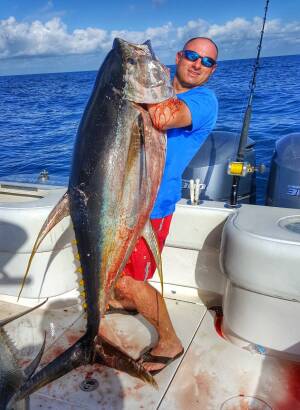Chunking for yellowfin tuna can be challenging but requires understanding the fish's behavior and the right size leader. Different fishermen use different strategies, including open water and man-made structures like oil platforms and deep water trawl boats. Yellowfin tuna are voracious feeders, so understanding their feeding habits is crucial for success in this expensive endeavor.
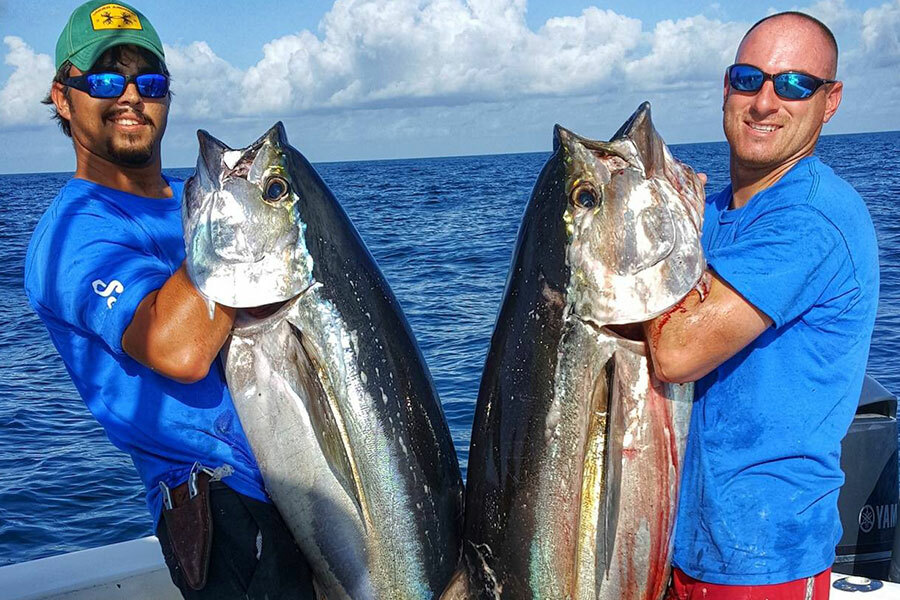
Chunking Yellowfin Tuna
Chunking Tuna is Easy, Right?
How difficult can chunking for yellowfin tuna be, right? You chop up some fish, toss it out and bam, a couple of hundos in the boat. Time to go in. Yeah, that would be a solid NO. A lot of fishermen struggle with catching yellowfin tuna. Where do you start with trying to improve your fishing? This can be an expensive endeavor, in both time and money. Depending on where you are located, tuna fishing can be long runs to the grounds, heaping amounts of time goes into preparation and then there's the money. Fuel, food, beverages, bait, tackle, travel all add up quickly. You really need to understand all the variables that go into chunking for tuna, if you want success. The planning and preparation is critical. Learning how really good fishermen around the country do it will go a long way to helping you develop a winning program.
Chunking for yellowfin tuna is not particularly difficult, but it does present certain challenges and requires a level of understanding about what the fish are doing and why. You can over chum or under chum. You can use the wrong size leader or hook you baits incorrectly. Fishermen in various parts of the country do things a bit differently, based on fishery dynamics and the nature of what draws fish to their area. What I am going to do is lay out a couple of different chunking for tuna strategies. I will share thoughts on fishing open water and man made structure like oil platforms and deep water trawl boats. What you have to understand is that yellowfin are voracious feeders, so they are going to be where food is available. In most cases, this relates to live bait, but there are cases where the tuna are feeding a by-catch that is cast of trawl boats.
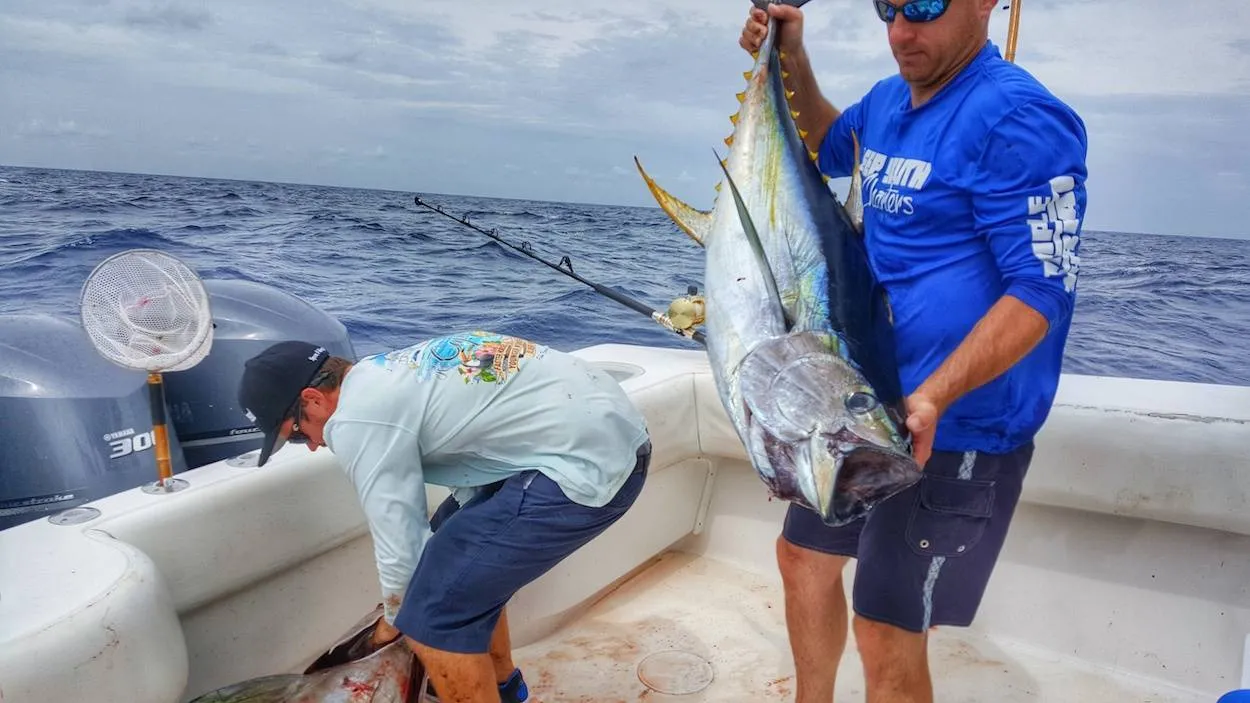
What is Chunking?
Chunking is a form of chumming, but let's delineate the two, so we are clear on what is being discussed. Chumming typically involves some sort of ground up or mashed up mix of bait. You see it in frozen blocks, many times. Oils like menhaden oil is also used in chumming, as an attractant. Chumming has a tendency to draw and hold smaller fish, but it does help attract fish by creating a scent trail in the water. When you think about chunking, ones mind probably goes to tossing out chunks of fish. This is very common, but you can also chunk with live bait. Chunks can range in size, based on what size fish you are targeting, but in essence it is solid pieces of fish, live or dead. Chunks are used to attract larger species to the party.
Chunking yellowfin tuna catches fish, hands down. That is why you hear so much about it. Fishermen will use whatever bait is readily available. Whatever combination of bait you use depends on the setup of your boat. Some boats have live wells and some don't. Some fishermen believe in using live bait and some don't. Whatever works for you is what you should use. Just because you have a big fancy boat with all sort of electronics to locate birds and giant live wells with tons of storage for all sorts of dead bait doesn't mean you are going to catch more than the solo guy in the small center console with no electronics using nothing but dead bait. Whatever kind of boat you have and wherever in the world you fish, there will be similarities in how you target yellowfin tuna. There will also be differences and subtle nuances that determine why you find success.
Best Tuna Fishing in the States, Maybe the World!
I have fished with some extraordinarily skilled yellowfin tuna fishermen in the Northeast, the Bahamas, the Gulf of Mexico out of Venice, Louisiana, Mexico, Costa Rica, Hawaii and Australia. I have been apart of using a wide variety of techniques and learned a ton along the way. I have to confess, my favorite place to fish for yellowfin tuna is Venice. The guys there have this game down. Everything is streamlined and fine tuned. Yellowfin and big yellowfin are there every year in numbers, so the crews there get a lot of time dealing with this species. None the less, this article will cover tactics and techniques for chunking yellowfin tuna from several places. The focus will be in chunking in open water and pulling fish off of structure by chunking. There should be plenty here to help you out.
The Finer Points of How Much Bait for Chunking
Lots of variables go into chunking. Depending on how long you intend to spend out on the water will determine how much bait you need to take. Whether you are going to carry live bait is a big factor. For over night or multi-day trips, take as much bait as you can carry. It is hard for me to tell you how much bait you need to take without knowing your boat size and setup. Nothing is absolute and yellowfin tuna feeding habits will change day to day or even withing the day, so be versatile. Take a variety of baits. It could be pilchards, pogies, blue runners, sardines, threadfin, finger mullet, butterfish or whatever your prevailing bait fish species happens to be. There are a lot of options. Here are some general guideline for day trips and multi-day trips. For day trips, 300-400 live baits is a realistic amount of bait. You should also carry a couple flats of frozen baits. This is a not a fixed number. Knowing how much you will need comes with experience, but it is better to have more and not use if than to run out when the bite is on. For multi-day trips, carry as much live bait as you possibly can. This can be two 100 gallon wells blacked out with bait or less. It all depends on your well capacity. You will also need somewhere around 75 lbs of frozen bait. If you cannot get or do not use live bait, take more dead bait. It is all a sliding calculus depending on what your boat can handle and your preferences. Just remember that the quality of your bait is huge. Tuna can get finicky, so be prepared.
How Do You Find Yellowfin Tuna?
Yellowfin tuna are where there is food. They eat a lot everyday. They don't stop swimming, so food is paramount. If you find the bait, you will find the fish. As with most any fishing, structure is where the bait will aggregate. Structure can take the place of natural bottom, channels, ledges, oil platforms and current. Yes, current. Current, especially colliding currents, pushes bait and in many cases traps it in a isolated area. When you look at either the Bahamas or the Gulf of Mexico, there is an interesting mix of significant structure and strong currents. That's why there is great fishing in both places.
In the Bahamas, you have the deep Providence Channel slamming lots of water into the Gulf Stream. Bait is naturally going to be at that point and that is why this area is a great yellowfin tuna fishery. The Gulf of Mexico, off of Louisiana, is an incredible mix of structure and current. The Mississippi River dumps out in the Gulf and runs head long into the Yucatan Current and it starts mixing around. There are amazing deep water drop offs, sea mounts and oil platforms everywhere. A wild card in the Gulf is the fleet of deep water trawlers. These boats will hold big fish. They are there to take advantage of the conveyor belt of by-catch that comes of the trawlers. Louisiana is perhaps the best yellowfin tuna fishery in North America and the Caribbean.
Find the Bait, Find the Yellows
Just like the current moves, so do the bait fish. There is a bait fish season just like there is a tuna season. Certain times of the year schools of yellowfin tuna will move through these areas or yours for that matter. It is just part of the migration. Knowing what bait is around and where you find it is critical. Some baits will be found further offshore and others closer in. Once you understand where the bait fish is predominantly found, you can go to those areas and start hunting.
Open water fishing where you are looking for birds, as indicators of bait, can try your patience. This is a game of cat and mouse with the birds. Some fishermen use advanced radar to locate birds and then run to intercept them, setting out baits way behind the boat and then cutting in front of the birds. By doing this, you are dragging lures through the school without running over the school. If you are chunking yellowfin tuna, start throwing chunks as soon as you hook a fish on your long lures. With live baits, wait until you start marking fish on your sounder to start throwing hooked chunk baits. Then you put out a few live baits. Chunks first and then live baits. Radar is not required to pinpoint the location and pattern of behavior for the birds. You can utilize binoculars to locate birds or you can setup in an area you know traditionally holds fish and wait for the birds to show. Many times birds will be working in a fixed area, flying in a circle pattern. If you see birds, sit tight, watch and wait for the birds to return. This will indicate how the bait and the tuna are moving. There are a lot of great fishermen that just figured out the birds patterns and set up their chunking operation accordingly. They just get in the path of the birds and wait. The line of baits they put will eventually be found by the tuna. You can do this from anchor or you can drift with the current.
Develop a Fishing Forecast Using Satellite Data
The use of offshore charting services also works well. You can research satellite maps that show chlorophyll levels, sst of sea surface temperature and altimetry. Chlorophyll levels correlate to area with a high probability of holding concentrations of baitfish. Altimetry levels indicate the presence or upwelling or downwelling. Upwelling is the vertical movement of water that carries oxygen and nutrient rich waters. This leads to the aggregation of bait. You can then use the coordinates from your mapping service to narrow down your search for birds. There will be times when yellowfin are feeding on shoals of bait without the presence of birds. So, be open the what the data tells you to make good judgement calls on where to start looking.
Understand Structure, All Types, to Catch More Tuna
Fixed structure is a little different. There is no searching for birds, but rather running to an oil platform and seeing if you can mark fish on your sounder. In the Gulf, the platforms hold most of the fish. The bait gathers there for protection. You may have to hit a few platforms, but the fish will be on the structure. Here you are drifting chunks into the structure creating a stream of food that attracts the tuna to your boat. The idea is to become the source of the food and then try to move away from the structure. With fish in your chunk stream, keep feeding out baits steadily in the current.
Deep water trawl boats are the ace in the hole. This type of boat set gear on the bottom to catch shrimp. As the pull their gear in, loads of by-catch has to be collected and discarded. As these boats just drive around catching shrimp or other fish, the continues stream of bait being tossed over the side creates a giant trail of bait. Trawl boats will hold really big fish, certain times of the year. These boats are not always around. This process creates a conveyor belt of food that makes for easy pickings. The tuna do not have to work that hard. There will be fish well over 100 lbs on the trawlers. You are going to need bigger leaders and bigger hooks.
The play here is to drive up to the trawl boats and use your sounder to mark fish. Trawlers will move in and out of clean water and dirty. Tuna fishing in dirty water will be less productive. Just be sure that the dirty water does not have clean a few feet below. You can check the trawl boats wash to see if there is any blue water. If there is, that is a good sign the dirty water is only on the surface. Once you know if there are fish on the boat, see if you can get any by-catch from the trawl crew. A lot of these guys are open to trading sacks of by-catch for drinks, cigarettes, beer, snacks, etc. The by-catch is an excellent bait option, since that is what the yellowfin tuna, blackfin, bonito and sharks are used to eating. You should of course have some flats of frozen pogies, sardines or whatever bait is available to you.
Baiting Strategically
By-catch, which is more readily available in the Upper Gulf of Mexico, will have bigger baits and bigger baits deter the blackfin and bonito, allowing the yellowfin tuna time to get baits. The fish in this scenario tend to be fired up from eating all the continuous by-catch being tossed into the water. What you will do is use your newly acquired by-catch to create your own slick. Chum the yellowfin tuna next to your boat and then pitch hooked baits to specific fish. You are essentially hand lining or feeding the fish you want. Keep a steady stream of baits going out to peel the tuna off the trawler. You are now the conveyor belt of food and the tuna will stay with you for the easy meal.
The key with chunking is to not throw out too much bait. The goal is to toss out 3 to 4 baits every 10-20 seconds or so. Vary the rate based on activity. Throwing too much is a mistake many fishermen make. Just keep a slow steady stream going and the tuna will hang out. Whatever you do, don't stop, even after hookup. Someone needs to be dedicated to this activity.
For Insights on Tackle, Watch Our Videos
I am not going to get into the tackle, as there is a lot of variation amongst fisheries. You can watch our videos and get hours and hours of information on tactics, techniques and tackle. The guys fishing the Bahamas use 3/0 to 4/0 hooks and the guys in the Gulf are using 7/0 t0 11/0. That should tell you a lot. Bigger fish eat bigger baits, which means bigger hooks. The best thing I can recommend is to use what has worked for you in the past. Chunking for yellowfin tuna is not an art, but it does have challenges. Learn from great fishermen, use the best techniques and catch the biggest fish.

